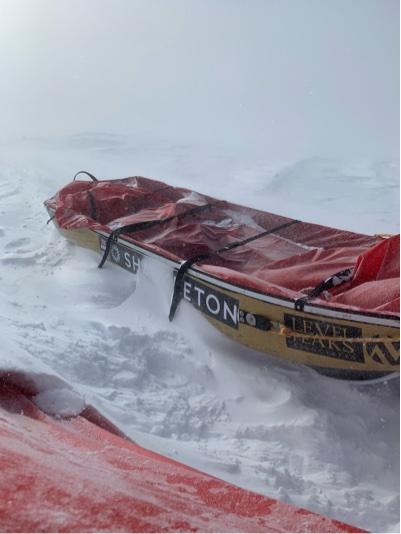In the soft snow, more expeditions face the decision whether to quit in week six of our Antarctica coverage.
Unassisted Solo Traverse
December 22 update: On Day 49, O’Brady clocked 61km in 13 hours — his record distance, and impressive by any standards. He now has 237km to go. Rudd is also doing well, but is 100km behind. With O’Brady likely to finish his crossing in about a week, it seems that he will win the informal race handily.

Lou Rudd pauses for a photo. The Geographic South Pole moves a short distance each year and has to be re-measured regularly. Photo: Lou Rudd
Colin O’Brady remains two long days ahead of Lou Rudd. He crossed the South Pole on December 12; Rudd, on December 13. With just over 300km to go, the finale promises to be a sprint to the finish.
Both men have now reached their high point at 3,000m and they will descend the rest of the way to the Ross Ice Shelf. As their sleds have lightened and uphill becomes downhill, their daily distances have, not surprisingly, shot up. O’Brady clocked 41km on day 46, the highest by either of them so far.

A recent map (December 19) charting both Rudd (blue) and O’Brady (green). Illustration: NYT
Both men have lost weight; Rudd estimates that he has shed at least 10kg. He also suffers from mysterious damage to his lips and mouth. His mouth is “just a mass of pus and blood”, making eating and even breathing painful. His explanation for this is vague: Is his face mask icing up and sticking to his lips? Is he eating jerky, which in the cold may become so hard that it’s like chewing razor blades?
In this bloodied state, Rudd ran into six Taiwanese skiers, supported by a full complement of vehicles, camp gear and their own cook. The group was skiing to the South Pole. The bizarre experience left Rudd a little bewildered and he was relieved to leave them behind.

Dwindling supplies have, at least, made the pulks easier to haul. Photo: Lou Rudd
After a brief smile of good weather around the South Pole, it has worsened in the last three days, and Rudd and O’Brady have both struggled. On day 47, after five hard falls and only two hours of skiing, O’Brady pitched his tent in the informally named Sastrugi National Park. He wondered whether he should risk continuing that afternoon. He eventually did, and fought through brutal winds to make over 34km. The next day, he slipped even more frequently, but again managed to scratch out 30km.
Grinding on in the same gale, Rudd has resorted to desperate measures to avoid any unnecessary wind exposure. Recently, he has performed his daily bowel movements inside his tent vestibule. He reassures his blog readers that he only sorts to this in the roughest conditions. Defecating outside in a gale is the most unpleasant part of any polar journey.
Solo to the South Pole

Abe has to make a tough decision in the next few days. Photo: Masatatsu Abe
Weather continues to cause havoc, forcing solo manhaulers to reconsider their goals.
Masatatsu Abe has reached a crucial juncture. He’s low on food and making laboured progress. As he approaches a potential resupply point, he is forced to consider whether to abandon his unsupported status and call in extra food, or to quit entirely. Moreover, the resupply would not only forfeit the coveted “unsupported” tag, but potentially create a lifetime of debt for the modest rickshaw driver: A food drop by Twin Otter costs north of $100,000 in these latitudes. He’ll have to make the decision soon.
Matthieu Tordeur still soliders on, but he can’t believe he’s on the driest continent. Fresh snow falls almost daily and he is struggling for kilometres as his pulk sinks in the soft powder. (After a snowfall, you need a day or two of wind for the surface to harden.) He has made it to 84 degrees South.

Tordeur has slowly ramped up his mileage, despite frequent snowfalls. Photo: Matthieu Tordeur
On December 16, after 21 days, Eric Larsen succumbed to the inevitable and abandoned his South Pole speed attempt. The unusually warm weather had severely slowed progress, and his target of 23 days had become improbable even after the first week. Faced with too little food and too much distance, Larsen skied back to Thiels Corner, where a chartered ALE plane picked him up.
Christian Eide’s 2011 pace remains intact for now, but another manhauler, Richard Parks, has also targeted Antarctica’s premier speed record. Parks left on December 19 and immediately encountered soft, wet snow. Despite this, he has made a lightning-quick start, cranking out over 40km on just his second day. He will be hoping that the late start will help him avoid Larsen’s fate.
Jenny Davis is finally off on her own women’s speed record attempt. Davis set out from Hercules Inlet on December 16. Traveling somewhat sedately, she has averaged about 18km per day. She will need to up her pace if she wants to break the 40-day mark.

After only five days, Jenny Davis is already speaking to her sled. Photo: Jenny Davis
Guided Expeditions

Doherty and company are at a standstill, channeling their energy into keeping their tents clear. Photo: Joe Doherty
Before the wind and the snow picked back up, Joe Doherty and the guided expedition enjoyed a couple of days of blue skies. They have since been stationary for two days, electing — unlike O’Brady and Rudd, embroiled in their personal race — to stay put until the weather improves. The group are using resupplies and can afford to be cautious.
Mt. Vinson

Union Glacier camp. Photo: Laval St Germain
Laval St Germain remains stuck at Union Glacier, where a recent blizzard destroyed eight tents. The strong winds mean that his climb of Mt Vinson will have to wait.
You can catch our previous update and the season introductions below:
Antarctica 2018-2019: Week Five
Antarctica Expeditions to Watch 2018-2019 Part 1
Antarctica Expeditions to Watch 2018-2019 Part 2






